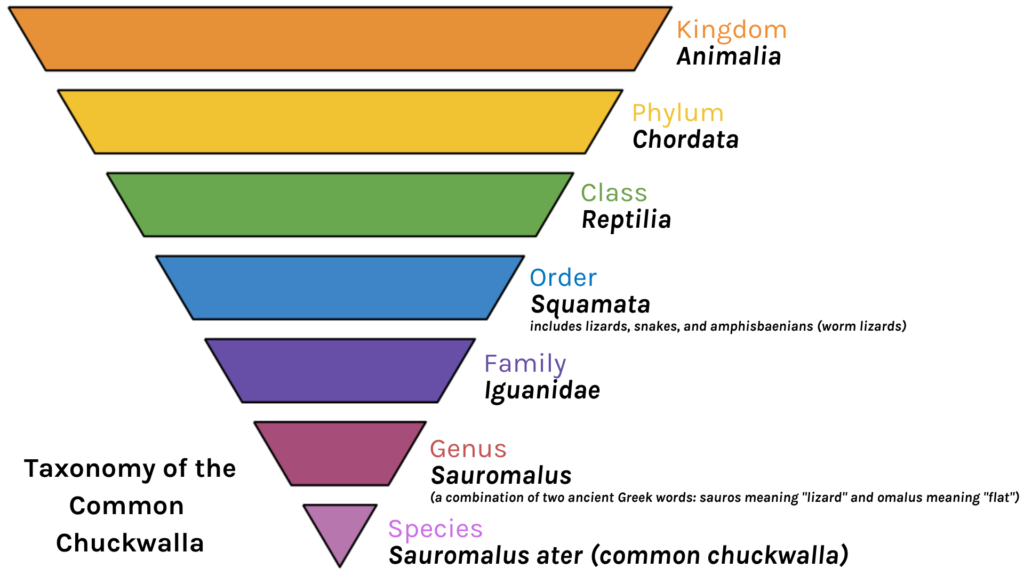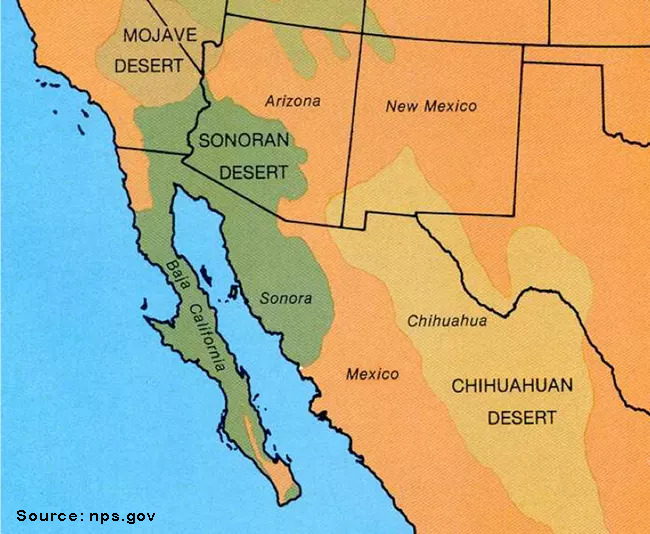What is a Chuckwalla?
The chuckwalla is a lizard in the iguanidae family, with a stocky build, a belly that sits low to the ground, and a thick, scaly tail that tapers to a blunt tip. Chuckwallas can grow up to 18” long, and typically survive fifteen years in the wild and up to twenty-five years in captivity! The color of their bodies helps them blend in and camouflage with their environment. Depending on outer temperatures and their mood, chuckwallas can lighten or darken their body colors. As more sunlight is absorbed to warm them up, the color of their skin becomes darker and the cooler they are. Likewise, as they absorb less sunlight, their body color will be lighter and that indicates that they are warmer. “Lucky”, the WonderLab chuckwalla, is a full-grown adult. Prior to becoming one of the Museum’s Animal Ambassadors, Lucky lived at IU’s Jordan Hall reptile exhibit.
Where do Chuckwallas Live Naturally?
Chuckwallas can be found in the Sonoran and Mojave deserts of southern California, southwestern Nevada, southwestern Utah, western Arizona, Baja California, and northwestern Mexico. They prefer living in lava flow regions and rocky areas which are usually covered in thorny, evergreen shrubs, such as greasewood.
It’s Grub Time!
Chuckwallas are herbivores, meaning their primary sources of food are plants. In the wild, they prefer eating yellow flowers, such as those of the brittlebush, greasewood flowers, fruits, leaves of desert plants, and occasionally insects as well. At WonderLab, Lucky the Chuckwalla eats a variety of vegetables, including dark leafy greens, squashes, zucchini, bell peppers, mangoes, and papaya, which are foods with similar nutritional contents as the food he would find in the wild. To ensure that Lucky gets to practice his natural instincts of foraging, food is sometimes sprinkled around his habitat instead of only placed in one designated area.
How do Chuckwallas Behave and Adapt?
When a chuckwalla feels threatened, it will crawl into a tight space, like a rock crevice, and inflate its lungs. Its body expands like a balloon, making it challenging for predators to extract them. Chuckwallas also have the ability to lose their tails to distract predators while they escape to safety. To mimic a chuckwalla’s habitat in the wild, Lucky’s habitat is reorganized and changed frequently so that it promotes curiosity and natural territorial and foraging behaviors. His habitat is also misted every now and then with a spray bottle to simulate rain.
Chuckwallas are “diurnal” meaning they are active during the day, like us humans. They are also “ectothermic” or “cold-blooded”. This means that they cannot produce their own body heat. Instead, their body temperature changes to match the temperature of their environment. Being diurnal, they can easily warm up by basking in the sun. They bask in the sun to also gain energy required for daily activities. At WonderLab, Lucky’s habitat is equipped with specialized heat lamps and lights timed to mimic the sun’s light and heat as it moves through the sky throughout the day. In the winter months from October to March when the temperature drops and food is scarce, wild chuckwallas undergo brumation, a type of hibernation for cold blooded animals, like reptiles.
Male chuckwallas are very territorial compared to female chuckwallas. The males push their bodies up and down, bob their heads vigorously, and open their mouths to create a gap as a way to communicate and defend their territories against other males. They will walk along the perimeter of their territories while displaying and marking their scent to establish their boundary. During the reproduction season, male chuckwallas compete for access to females. Their fights usually consist of biting and head knocking.
Lucky’s lifestyle at WonderLab!
Our goal at WonderLab is to provide enriching experiences that mimic the natural experiences that our animal ambassadors, such as Lucky, would have in the wild. To do this, the Animal Care Team set up what we call “autonomous” handling time. This is when staff set up a safe space outside the habitat for Lucky to engage in rewarding challenges such as obstacle courses or hunting exercises. This spurs curiosity in Lucky and allows him to make choices for himself.
Animal Care Staff also engage in “facilitated” handling, which is when the staff takes time to actively engage with our Animal Ambassadors by holding them. This keeps them comfortable being around humans and builds bonds and trust between the animals and their handlers.

References
Britannica, T. Editors of Encyclopaedia (2020, February 25). iguanid. Encyclopedia Britannica. https://www.britannica.com/animal/iguanid
Chuckwalla diet, facts, Venom, bite, care, habitat, lifespan. Reptiles Facts. (n.d.). Retrieved January 7, 2022, from https://reptiles.factsdiet.com/lizard/chuckwalla/
Chuckwalla. CRITTERFACTS. (2021, May 5). Retrieved January 7, 2022, from https://critterfacts.com/chuckwalla/
Encyclopædia Britannica, inc. (n.d.). Reptile. Encyclopædia Britannica. Retrieved January 7, 2022, from https://www.britannica.com/animal/reptile
Couch, S. (2021, November 29). Personal communication [In-person interview][/fusion_text][/fusion_builder_column][/fusion_builder_row][/fusion_builder_container]




Leave A Comment